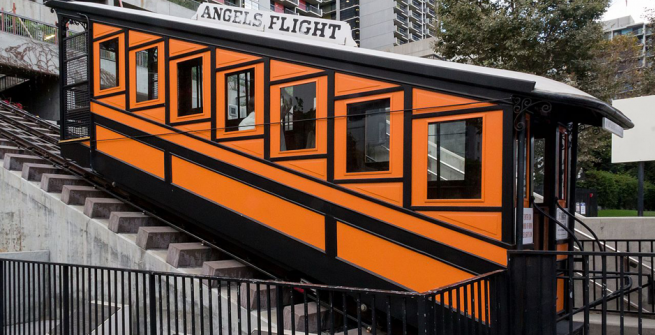Welcome back, Olivet and Sinai.
The two orange and black 16-seat wooden cars named for the biblical mountains will resume climbing up and down Bunker Hill tomorrow. Angels Flight first began making the ascent up Bunker Hill on December 31, 1901. Over 2,000 passengers “made the flight” between Hill and Olive Streets that day, including Los Angeles Mayor Meredith Snyder.
In 1901, Bunker Hill was a most desirable residential neighborhood. Doctors, bankers, and lawyers lived in ornate Queen Anne mansions; and elegant hotels like the Melrose and the Richelieu welcomed guests. The city’s business district sat just below the hill, to the east.
But Bunker Hill sat atop a steep promontory and access was difficult. Colonel James Ward Eddy came up with the idea of a funicular railway to provide easy and reliable transport up the steep incline. After the City Council approved his petition, Eddy began construction on August 2, 1901. He completed the funicular railway in just 5 months. The railway ran every day from 6:00 am to 12:20 am and the fare was 1 cent, or 3 rides for a nickel.
By the 1920s, Bunker Hill was in decline. The city’s elites moved west and the once grand mansions became boarding houses and apartment hotels. In 1959, the Los Angeles Community Redevelopment Agency adopted a massive redevelopment plan for the area and by 1968 the old Bunker Hill neighborhood had been completely leveled.
Angels Flight made its last trip at its original location next to the Third Street tunnel at 10:30 p.m. on Sunday, May 18, 1969. In 68 years, Olivet and Sinai carried over 100 million passengers and traveled 15.6 million miles, more than 600 times around the earth. The fare was raised only once, in 1914, from a penny to a nickel.
Olivet and Sinai languished in a warehouse until March 1995, when the railway was refurbished and relocated to its current location, a half block south of the original site.
At its new location across from Grand Central Market, Angels Flight ran until February 2001 when one of the cars derailed, resulting in the death of a passenger and seven injuries. After nine years of legal wrangling, the railway reopened in 2010. A second derailment in 2013 has kept the railway closed until now. Thanks to a private-private partnership (with an assist from the Mayor's Office), Angels Flight has undergone $5 million of safety upgrades, including the addition of an emergency stairway.
Fresh off its cameo appearance in the 2016 Oscar-nominated film La La Land, the Angels Flight railway will open to the public again today. The fare has gone up a bit since 1901—a one-way trip will cost $1. (TAP card holders can purchase a ride for 50 cents.)
One of Los Angeles’ most beloved landmarks, Angels Flight is City of Los Angeles Historic-Cultural Monument No. 4. If you have never ridden Angels Flight, do yourself a favor and take a ride on this Los Angeles treasure.
Further Reading
- Angels Flight: A history of Bunker Hill’s incline railway by Virginia L. Comer
- Angels Flight by Walt Wheelock
- Two angels on a string the story of Angels Flight by Donald Duke
- Los Angeles's Angels Flight by Jim Dawson
- Bunker Hill in the rearview mirror: the rise, fall and rise again of an urban neighborhood
- Los Angeles's Bunker Hill: Pulp fiction's mean streets and film noir's ground zero! by Jim Dawson






